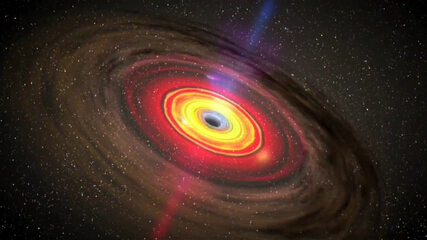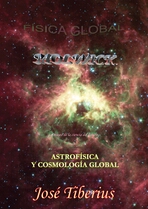1.b) Black holes and contraction of the Universe
It is worthwhile to read the book on Global Mechanics to understand the proposals for Astrophysics and the black holes –black balls–; in particular, section referring to subatomic particles and the mechanisms for the creation of mass.
Global Mechanics has given the name of black interaction to the phenomenon of creation and formation of physical mass, as it is a different –albeit related– phenomenon to gravitational and electromagnetic interactions.
The inverse phenomenon to black interaction would be white interaction, conversion of mass into electromagnetic energy and relaxation of the longitudinal tension of the Global Aether. An example would be a star breaking up in a nuclear fusion reaction. Indeed, it is the interaction of mass in its two manifestations of creation and destruction or transformation.
This section of Global Physics on Astrophysics aims solely to note some general ideas, without going into detail.
We have decided to change the name of black holes gradually for black balls because, according to Global Physics, these astronomical objects have nothing to do with a hole and appear to be like a giant ball. We use the new name particularly for the case of supermassive black balls.
It is not about change for the sake of change; it is about aiding the brain in using intuitive thought and logic processes when it comes to complex topics such as these, due to the lack of experimental information available, and many physical theories of a purely mathematical nature. Also, it serves to situate the brain within the Global Physics model.
Special care must be taken with physical theories of a mathematical nature because they do not know where the physical limits of their mathematical functions lie. A current example may be that the mathematical models of Modern Physics only explain 4% of the energy-mass of the universe; not because it is so, but because they surely apply functions outside their context or limits of their physical relationships.
We are going to divide the exhibition into two large sections; the first on the concept, formation, types and main effects of black holes in general.
The second section contains proposals of Global Astrophysics about the concept, origin, characteristics, and effects of supermassive black balls.
Such proposals can alter ideas about the origin of the universe, galaxies, and stars.
1.b.1. What is a black hole or black ball?
Concept
We must recognize that the concept of a black hole in space-time (strings, quantum foam, aether or any other name) has been a hole in itself, where theories of all kinds seem to fit.
The exotic phenomenon known as a wormhole connects two parts of the Universe –also known as Einstein-Rosen bridge across space-time– with a gravitational tunnel through which mass and energy absorbed by a black hole could pass. A wormhole does not seem reasonable given the gravitational effects of the black holes and characteristics of the Global Aether.
The idea of wormholes that connect two different or parallel Universes is perhaps best not to comment on –at least, from a scientific point of view.
Another quite nice way to characterizing black holes or black balls is to say that they consist of atoms and particles in a state of plasma. However, according to Wikipedia, interstellar space contains plasma, the interior of stars is also plasma, and we have plasma ornaments with pretty lighting effects; so, we have concluded that it is perhaps best not to mention plasmodium too much, so as not to confuse people more than necessary. At least not in a book like this, which does not aim to possess a detailed technical precision.
The intention is not to criticize Wikipedia; it seems that plasma refers to a phase of matter –different from solid, liquid or gas– characterized by its composition of ions or charged particles moving freely.
The black holes and the stars are somewhat more complicated than plasma; in fact, we would say anything but free, which is not saying plasma is easy to describe in its various manifestations.
The Global Physics, an intuitive interpretation of QM and GR, talks about primary phases of the reticular structure of matter or the Global Aether, such as total symmetry, radial symmetry –or gravity–, transversal symmetry –or electromagnetism–, and compressed matter –or mass.
The most straightforward idea of a black hole is an astronomical object composed of compressed reticular matter or mass, which generates sufficient gravity avoiding electromagnetic energy to escape; as such, it appears black from the outside. Thus, it is not only capable of capturing electromagnetic energy passing through its area of influence, but also does not allow electromagnetic energy produced in its interior to escape.
The black holes are like huge balls made up of little balls and ball in development; they absorb the mass and electromagnetic radiation that reaches them via the creation of loops and curls in their interior due to the forces of torsion that act on them. The formation of these loops neutralizes the tension of transversal elasticity, as it transforms it into the tension of longitudinal curvature and energy of reversible deformation due to the compression of Global Aether.
Formation of black holes
We must take into account that at the end of the last century, scientists use to say it was possible a black hole could exist in each galaxy. Now, they talk of millions in massive galaxies.
The process has various stages, and not all of them are necessary.
In Modern Astrophysics, there are various theories regarding the origin of planets. It is almost sure that in outer space there exist planetary systems with different formation processes.
Black hole (CC0 Public domain image) 
According to Wikipedia, the most widely accepted theory, and the one that would explain the majority of planetary systems is that of cosmic dust before and after the birth of stars and post accretion disk.
However, for Global Physics the origin of the enormous quantities of cosmic dust needed to generate so many stars and in many cases with a specific distribution, as in spiral galaxies, is not adequately explained.
It is possible that in the enormous initial explosion of our local Universe –the Little Bang– large masses formed in a short time, capable of provoking reactions of nuclear fusion leading to the birth of stars, neutron stars or directly a black hole.
-
Characteristics of black holes
Everything is possible in Nature, with perhaps a few exceptions, like forces at a distance, pure telepathy, additional spatial dimensions, multiple realities depending on the observer and time-travel.
The only thing that these anti-intuitive concepts achieve is to hinder scientific development unless we understand them as mere temporary tricks of science until the underlying physical reality is discovered by one and the other. We could say that these epistemological impossibilities make up an anti-all theory or a dark goal.
Composition and internal structure
Black holes could be a collection of fundamental particles because high gravitational energy could split the nuclei of the atoms.
-
Mass and size
By the concept itself, the minimum mass should achieve a sufficient global gravitational attraction not to allow electromagnetic energy to escape.
It is unknown what the maximum size may be, but it would be logical for it to exist, however large it might be.
-
Rotation
Black holes have rotation movement. This characteristic could be a consequence, in addition to the rotation of the stars that originate them and how the corresponding absorptions and mergers take place, of the transverse nature of the electromagnetic energy.
Simple Physics experiment
Hold an elastic band by its ends and twist it in opposite directions until little ball forms in the center.
Keep twisting to the ends and see what happens!
-
Black holes and anti-black-holes
Like fundamental subatomic particles, there could exist two types of black holes: right-handed and left-handed. Although gravitational attraction will always exist, from the perspective of the supported magnetic field, two corresponding black holes should repel each other and two different ones should attract; it seems to be the age-old story. The only thing remaining would be if sexuality were a right-handed to left-handed attraction, like political dynamics.
It is convenient to point out that an anti-black-hole would not be a star or white fountain, but similar to the terminological relation between matter and antimatter. The opposite phenomenon to the creation of mass –black hole– is the destruction of mass –white fountain or star–, and this is not the same as the creation of a mass of a right-handed or left-handed nature.
In other words, the right-handed or left-handed nature of mass or electromagnetic energy will relate to the concepts of matter and antimatter. If a black ball is right-handed, its anti-black-ball will be a left-handed black ball.
-
Effects of black holes
Gravitational attraction on mass and energy
This effect comes literally from its definition or concept.
Emission of mass and electromagnetic energy
We know that some black holes emit significant quantities of matter in short periods.
In section 1.b.2 "Supermassive black balls" this effect will be analyzed in greater depth.
Contraction of the Universe
The phenomenon known as the contraction of the Universe occurs in the close area of influence of each black hole from the first stage of creation of cosmic dust. Likewise, it happens on a small scale with the particles with mass and the creation of loops or curls with the absorption of electromagnetic radiation and compression and compaction of the Global Aether.
The contraction of the Universe will be a similar phenomenon to that of a displacement in a three-dimensional spider’s web when one tug towards the middle and a central ball creates –with the material of the strands– containing many little balls.
Other physical theories might call these phenomena contraction of space; they understand space –erroneously in our opinion– like the mathematical points corresponding to Global Aether in Global Mechanics. Thus, if the Global Aether compresses, there will be a contraction of the Universe due to the contraction of space according to these theories.
The stars or white fountains will produce the opposite phenomenon –or expansion of the Universe– with the emission of electromagnetic energy, consequence of the white interaction or decompression of the reticular matter in the nuclear reactions. Therefore, we could say the named dark energy in the visible Universe is white energy.
-
Collision
This type of mergers seems to be a normal phenomenon now that there may be millions in massive galaxies.
Mergers of neutron stars and black holes have been observed experimentally with gravitational wave detectors such as LIGO.
